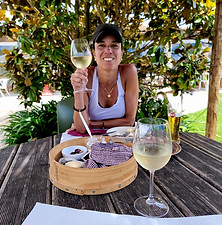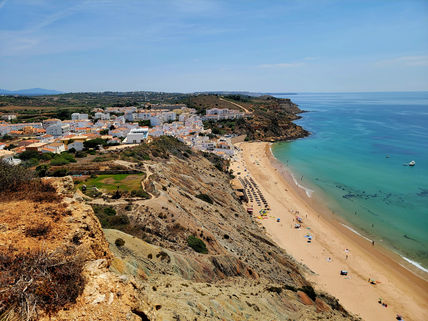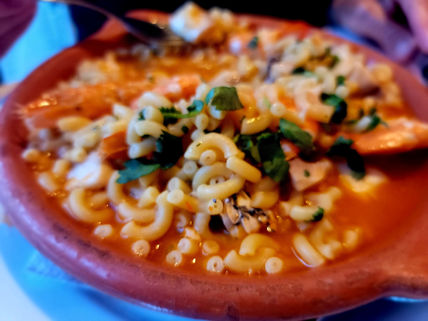top of page
Enlightened Adventures

Fisherman's Trail
The Fisherman's Trail is a scenic coastal trail that stretches along the southern coast of Portugal. As you walk, the ocean is almost always in sight and the views are spectacular. The brightest blue water crashing into the cliffs below, secluded golden sand beaches, it's a true paradise. To top things off, the food in Portugal is phenomenal. The small fishing villages along this trial have the freshest seafood of anywhere I have traveled to. Its absolutely outstanding. For an outside the box hike that's not in the mountains, this one is a top pick.
History
The Fisherman's Trail, part of the larger Rota Vicentina trail network, is a relatively new addition to Portugal's hiking scene. It traces the country's stunning coastline, offering hikers breathtaking views of cliffs, beaches, and traditional fishing villages. The trail's development began in the late 20th century as a way to promote sustainable tourism and preserve the region's natural beauty.
The Fisherman's Trail has gained popularity for its unique blend of natural beauty and cultural heritage. Hikers can experience the region's rich fishing history, witnessing traditional practices and quaint fishing villages. The trail's emphasis on sustainability ensures that visitors can enjoy the area's pristine environment while minimizing their impact.
As a result, the Fisherman's Trail has become a symbol of responsible tourism in Portugal. It offers visitors a chance to connect with nature, immerse themselves in local culture, and contribute to the preservation of this stunning coastal landscape.
Gallery
The Hike
The Fisherman's Trail, a stunning 130-kilometer coastal path along Portugal's southwest coast, offers a unique and challenging hiking experience. This trail, part of the larger Rota Vicentina network, is renowned for its dramatic cliffs, pristine beaches, and quaint fishing villages.
The Trail's Allure
The allure of the Fisherman's Trail lies in its raw, natural beauty. The rugged coastline, sculpted by centuries of wind and waves, offers breathtaking panoramic views of the Atlantic Ocean. As you traverse the trail, you'll encounter a diverse landscape, from towering cliffs to sandy beaches, hidden coves to lush green valleys.
A Physically Demanding Journey
The trail is physically demanding, requiring a good level of fitness and endurance. The terrain can be challenging, with steep ascents and descents, loose rocks, and deep sand. Even if you are use to hiking mountains, the deep sand will take its toll.
Key Considerations
-
Best Time to Hike: Spring (April-May) and Autumn (September-October) are ideal times to hike the Fisherman's Trail. The weather is pleasant, and the trail is less crowded.
-
Accommodation: Along the trail, you'll find a variety of accommodation options, including guesthouses, hostels, and hotels. It's advisable to book in advance, especially during peak season.
-
Luggage Transfer: Consider a luggage transfer service to avoid carrying heavy backpacks. This allows you to travel light and enjoy the hike more fully.
-
Essential Gear: Sturdy hiking boots, waterproof jacket, sunscreen, hat, sunglasses, and a reusable water bottle are essential items.
-
Trail Markings: The trail is well-marked with blue and green stripes. However, it's always a good idea to have a map and guidebook.
-
Respect for the Environment: Please adhere to Leave No Trace principles. Pack out all your trash, respect wildlife, and stay on the designated trails.
Hiking the Fisherman's Trail is a truly amazing experience. Walking along the steep coastal cliffs, looking out over the magical blue water of the Atlantic, eating the freshest seafood, its like a dream. A very, very good dream and there is no alarm to wake you from it. This is a trip not to be missed!
If you would like a detailed account of my experience or have questions about how to plan your own, contact us at
We'll get you there!
Food & Wine
I cannot speak highly enough about the food in Portugal. It is a simple, but amazing cuisine that will have you begging for more. Try anything and everything! Here is a list of some things not to miss.
Seafood:
-
Bacalhau à Brás: Shredded codfish with scrambled eggs, onions, and potatoes.
-
Polvo à Lagareiro: Grilled octopus with olive oil, garlic, and potatoes.
-
Amêijoas à Bulhão Pato: Clams cooked in a white wine, garlic, and cilantro sauce.
-
Caldeirada de Peixe: Fish and shellfish stew with potatoes, tomatoes, and herbs.
-
Sardinhas Assadas: Grilled sardines with salt.
-
Arroz de Marisco: Seafood rice with various shellfish.
-
Cataplana de Marisco: Seafood stew cooked in a clam-shaped pot.
-
Percebes: Goose barnacles, a prized delicacy, often served boiled or grilled.
-
Whole Squid: Grilled or fried, a simple yet delicious dish.
-
Clams: Often served in a white wine and garlic sauce.
-
Mussels: Steamed or grilled with various sauces, such as marinara or white wine.
-
Açorda: A bread soup, often served with fish or seafood.
Meat:
-
Porco Alentejano: A slow-cooked pork dish, often served with roasted potatoes and a hearty red wine sauce.
-
Cozido à Portuguesa: A traditional Portuguese stew with a variety of meats, including pork, beef, and sausage, along with vegetables and chickpeas.
-
Leitão à Bairrada: Roasted suckling pig, a specialty of the Bairrada region.
-
Francesinha do Porto: A hearty sandwich from Porto, filled with various meats, cheese, and a spicy sauce.
Cheese and Charcuterie:
-
Queijo de Serpa: A hard, dry cheese with a nutty flavor.
-
Chouriço: A spicy, cured sausage.
-
Presunto: A dry-cured ham.
Pastries and Sweets:
-
Pastel de Nata: A custard tart, a Portuguese pastry delight.
-
Queijada de Sintra: A sweet cheese tart.
-
Bolo de Arroz: A rice cake, often served with honey or jam.
-
Serradura: A layered dessert with cream, biscuits, and coffee.
Local Wines
-
Alentejo Wines: Known for their bold, full-bodied reds, often made from Touriga Nacional, Aragonez, and Cabernet Sauvignon grapes.
-
Vinho Verde: A light, refreshing white wine, perfect for pairing with seafood.
-
Port Wine: A fortified wine produced in the Douro Valley, often enjoyed after a meal.
-
Algarve Wines: Known for their fruity, aromatic white wines and full-bodied reds.
-
Madeira Wine: A fortified wine produced on the Madeira Islands, often enjoyed as an aperitif or dessert wine.
FAQ's
General Questions
-
What is the Fisherman's Trail? The Fisherman's Trail is a long-distance hiking route along Portugal's southwest coast, offering stunning coastal views, charming fishing villages, and diverse landscapes.
-
How long is the Fisherman's Trail? The full trail is approximately 130 kilometers (81 miles) long.
-
How difficult is the Fisherman's Trail? The trail offers a range of difficulty levels, from moderate to challenging. Some sections involve steep ascents and descents, while others are relatively flat.
-
What is the best time to hike the Fisherman's Trail? The best times to hike the trail are spring (April-May) and autumn (September-October) when the weather is mild.
Planning Your Trip
-
How do I get to the starting point of the Fisherman's Trail? The most common starting point is the village of Porto Covo. You can reach Porto Covo by train or bus from Lisbon or Porto.
-
How long does it take to hike the entire trail? It typically takes 7-10 days to hike the entire trail, depending on your pace and the number of rest days you plan to take.
-
Do I need a guide to hike the Fisherman's Trail? While a guide isn't strictly necessary, it can be helpful, especially for first-time hikers or those who want to learn more about the local history and culture.
-
What type of accommodation is available along the trail? You'll find a variety of accommodation options along the trail, including guesthouses, hostels, and hotels. It's advisable to book in advance, especially during peak season.
Packing and Preparation
-
What should I pack for the Fisherman's Trail? Essential items include sturdy hiking boots, waterproof jacket, sunscreen, hat, sunglasses, a reusable water bottle, and a first-aid kit.
-
How much water should I carry? It's important to stay hydrated, especially during the warmer months. Carry plenty of water and refill your bottle at water sources along the trail.
-
What should I eat while hiking the trail? Pack energy-rich snacks like nuts, dried fruit, and energy bars. You can also enjoy local delicacies at restaurants and cafes along the trail.
Trail Etiquette and Environmental Impact
-
What is the Leave No Trace principle? The Leave No Trace principle is a set of guidelines for minimizing your impact on the environment. This includes packing out all trash, staying on designated trails, and respecting wildlife.
-
How can I minimize my impact on the environment while hiking the trail? Follow the Leave No Trace principles, avoid littering, and be mindful of the local flora and fauna.
bottom of page
























































